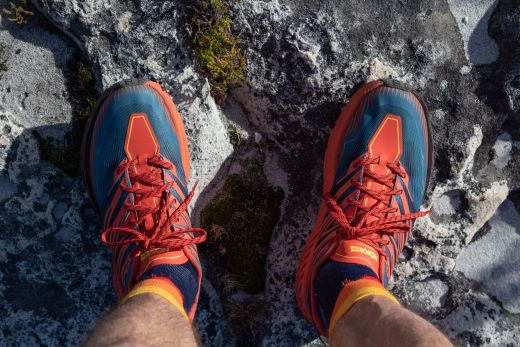No piece of kit affects your running as much as your shoes. Not your race vest, not your shorts, and definitely not your GPS-enabled watch. The right shoes, on the other hand, will help you dance through the techy bits, make the miles easier, and reduce the risk of injury. Conversely, the wrong shoes will see you hobbling back to the trailhead after just a few kilometers. But, with so many factors to consider, how do you choose the right shoes? Trail runners can have more or less cushioning, wider or narrower toe boxes, and bigger or smaller lugs in their tread. Luckily, you have this gear guide to simplify things for you.
Running shoe myths debunked
Science is ever evolving, and some beliefs that held water just a few years go have since been proven to be incorrect. Here’s the low down on some ideas about footwear design and choice that were once very popular but have since been debunked.
You need the support of stability shoes
‘Stability’ shoes are designed to prevent your foot from rolling inward and, in some cases, to stop a runner’s arch from collapsing. These designs are based on an outdated belief that the movement of your foot has to be artificially controlled to ensure proper biomechanics. False – your feet have muscles that can do the job just fine once properly conditioned. Humans did not evolve to chase down prey with the help of the tech you find in some Nikes. If there is anything to be learned from the barefoot revolution, it’s that your feet don’t need the level of support many brands claim they do. Some runners, especially beginners, need more support, but that just means a more cushioned and protective midsole.
Zero-drop shoes are specialists
Minimlaist shoes are specialist. There’s no denying that. But not all zero-drops are minimalists. Some have as much as a 29 millimeter stack height from toe to heel – enough cushioning even for distance runners. What makes zero-drops different to other more conventional shoes is that they have no drop in height from heel to toe. With proper transitioning, almost any runner can swap to zero-drop and benefit from a flatter shoe. To learn more about the advantages of zero-drops, see my articles on the benefits of zero-drop shoes and how to transition properly.
Lighter shoes will make your faster
If the weight difference between two pairs of footwear were big enough (like that between boots and shoes), it could be a factor, but when it comes to trail runners with less than a 65 grams (2.3 oz) between them, the performance advantages of a slightly heavier shoe will often offset the slight weight advantage of a lighter pair. In this case a 65 gram difference will not make a distance runner any faster, but the extra cushioning and protection in the heavier shoe could give a runner the support she needs to carry on going. Lighter shoes might give well conditioned runner a very slight advantage, but if you are a new or average runner, prioritise all other factors over weight.
What to look for in a pair of trail runners
There are dozens of features and factors that you could agonise over when choosing a new pair of trail running shoes, but the following are the most important.
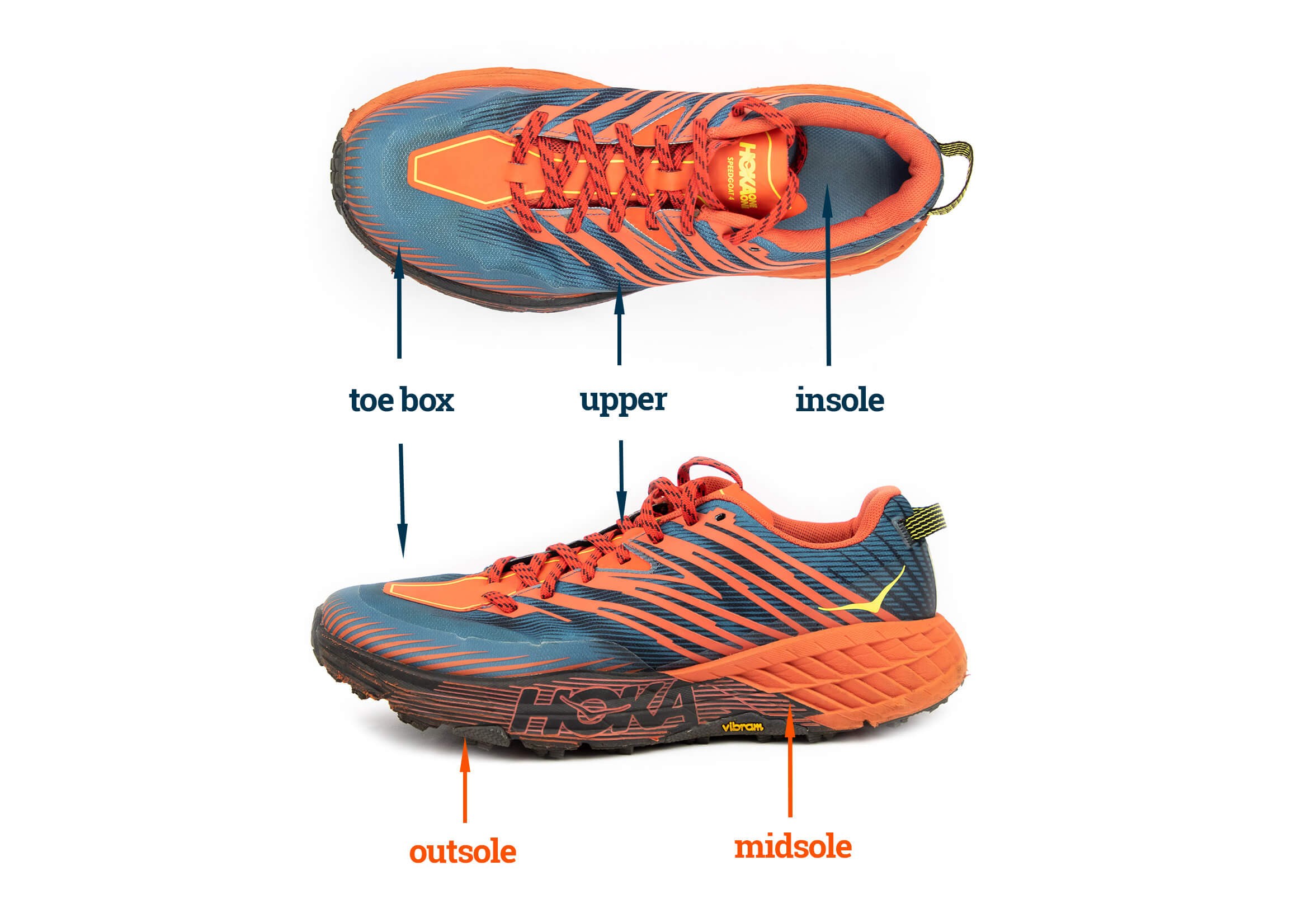
Outsole
The tread pattern in a shoe’s outsole determines how much grip it will give you and what kind of terrain it will perform best in. Deeper lugs will give you more grip in loose, muddy, and steep terrain while smaller, more tightly spaced lugs will perform better on hard-packed, dry trails, where they will give you more stability and efficiency. If you’re just starting out and aren’t sure what you’re going to ask of your shoes, look for a moderately aggressive outsole with lugs around three or four millimeters deep. These versatile allrounders will perform on almost any type of trail. Most shoes designed for trail running have outsoles that will perform on a variety of surfaces, and most runners will benefit from looking at the next three factors before fussing over tread pattern.
Stack height
Stack height refers to the amount of material between the runner’s foot and the ground. Although this measurement includes the outsole and insole, it’s a good indication of the amount of cushioning in a shoe. If a shoe isn’t a zero-drop, the stack height between the heel and toe will differ. Minimalist or barefoot shoes have little to no cushioning and low stack heights. Well cushioned running shoes can have a stack height of 30 millimeters or more in the heel. Seasoned runners might want less cushioning to give them a better feel for the trail and keep weight down. But if you’re just starting out, it would be safer to choose shoes with a generous amount of cushioning – at least 25 millimeters. The same applies to bigger runners and those running long distances – both can benefit from more cushioning and support.
Drop
Drop refers to how many millimeters of drop there are from heel to toe. Shoes with chunky heels have as much as 12 millimeters of drop while the flattest shoes have zero drop. Most shoes have a heel with significant drop, but there is an advantage to low-drop shoes. Shoes with raised heels tend to put your heel in contact with the ground before the rest of your foot. The result is a heel strike, which isn’t great for a few reasons. First, heel striking puts more strain on your joints and can lead to injury if overused. Second, it’s less efficient since much of the energy generated in a stride is lost on impact. And third, your heel offers less surface contact or control than your midfoot.
But there is also a point at which more cushioning becauses more of a disadvantage than a benefit. The biggest downside to more cushioning is actually not weight. It’s instability. A high stack puts your foot further from the trail. This can make it easier to roll your foot if you don’t put it down flat, and can result in a slightly disconnected feeling – unsettling if you run technical trails and are used to being able to feel what’s underfoot. Earlier this year I swapped back to Lone Peaks from a pair of Speed Goats for this exact reason. Most brands publish stack height as a spec. Others only describe shoes as having minimal, moderate, or maximum cushioning.
Uppers
The vast majority of running shoes have breathable uppers for a reason. Your feet sweat, especially while running, and nonporous uppers like those found on ‘waterproof’ shoes can trap moisture inside a shoe and turn it into a biohazard zone. Despite the claims made by the likes of Gore-Tex, water-resistant fabrics aren’t nearly breathable enough if you’re properly sweating. That said, there are situations where waterproof uppers make sense – they can do a good job of keeping your feet warm and dry in snowy conditions (real snow, not slush) and can be just the ticket for winter runs. Gaiters can help prevent snow from entering through the heel cuff.
Toe box
Some shoes have a wider-than-normal toe box. The idea here is to allow your toes to splay out and engage the ground as they would if you were running barefoot and with a natural gait. Besides encouraging better biomechanics and a reducing the chances of medial forefoot pain, a wider toe box also gives your feet some much needed room when they start to swell – a common affliction among distance runners. But the extra wiggle room might not be for everyone. Runners with narrow feet might find that wider toe boxes create too much space and feel a bit clumsy. I have narrow feet, and this was my first impression of my first pair of Altras. Since then I’ve learned to appreciate the extra width and am now on my third pair of Lone Peaks. Ultimately it comes down to preference.
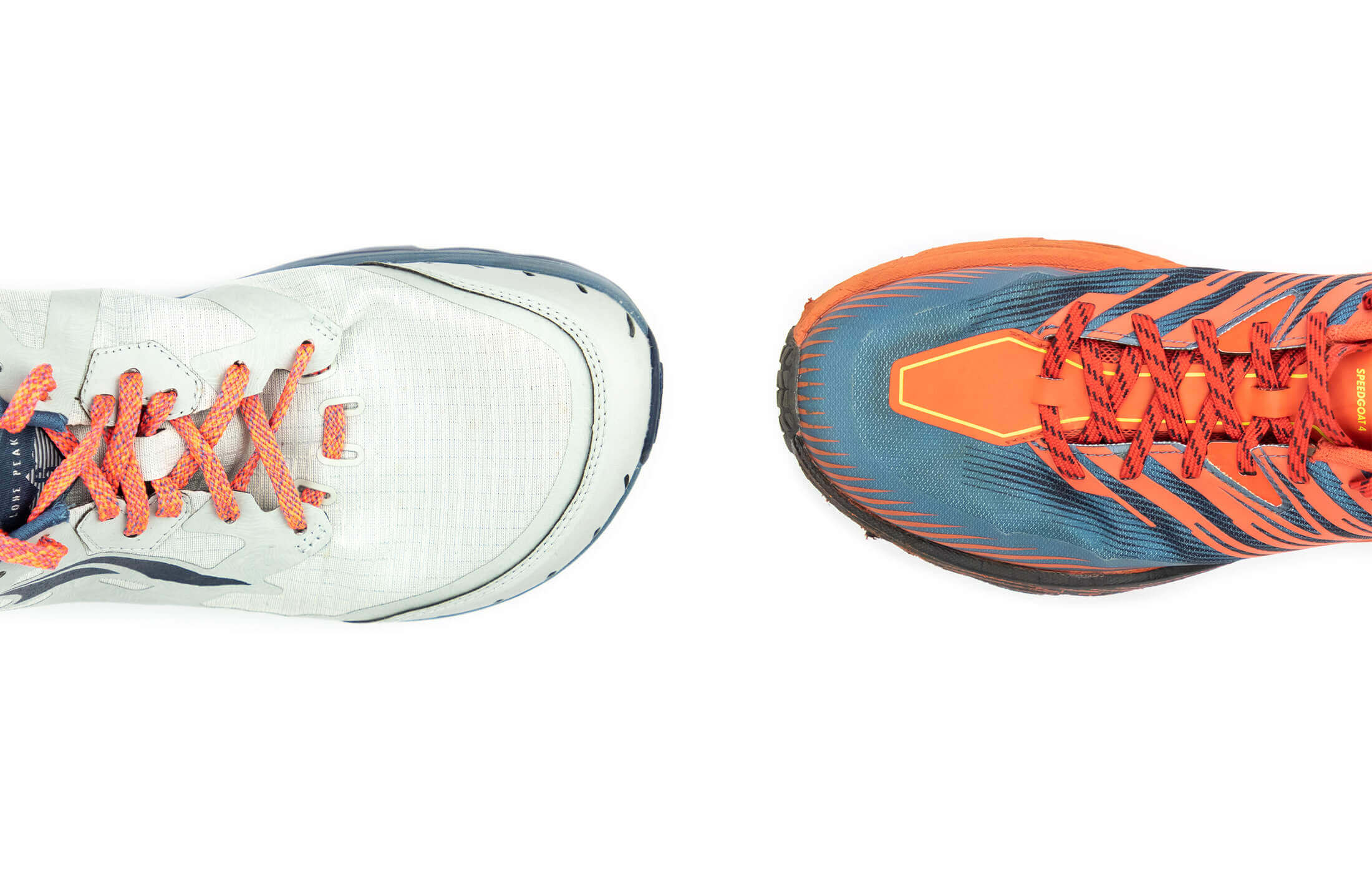
Different strokes for different folks
If you’re still scratching your head and wondering what it is you should be looking for in a trai runner, here are some guidelines for three kinds of runner.
Rookie runner
As a newb you need something very middle-of-the-road – at least 25 mm stack height and a drop that you’re comfortable with or used to. If you want to go down in heel drop (there are benefits), don’t go down more than 4 mm from your previous running shoes or trainers unless you are prepared to transition. If your last outdoor shoes had a 10mm heel drop, you could safely go down to a 6 mm heel drop. Lastly, make sure that you have enough space around your toes (see guidelines below). Your running shoes might need to be roomier than you’re used to.
Speedster
Fleet-footed runners will benefit most from light, low profile shoes. A stack height of 20 mm or less will ensure that you feel connected to the trail and reduce the risk of a rolled ankle. You won’t have as much protection from rocks and pebbles underfoot, but as a seasoned mountain runner, you don’t really need it. Some goats might even opt for minimalist shoes with a stack height as low as 8 mm. More speed also means more lateral force when changing direction, so it’s also important that this shoe is sized just right. You don’t want to slide around inside your shoes when cornering quickly.
Ultra runner
Distance running calls for a different type of shoe, one with significant stack height – 25 mm or more – and a wider toe-box. The generous cushioning will help support your feet when they grow tired, and extra room up front will help prevent hammer toes and blisters when you're clocking up the miles – during longer runs your feet will swell, which can lead to cramped, sweaty toes if you put them in a narrower shoe. It’s here that the wide toebox of a shoe like the Altra Lone Peak really shines. On that note, you will consider swapping to a pair of zero-drops or at least low-drop shoes if you haven’t already.
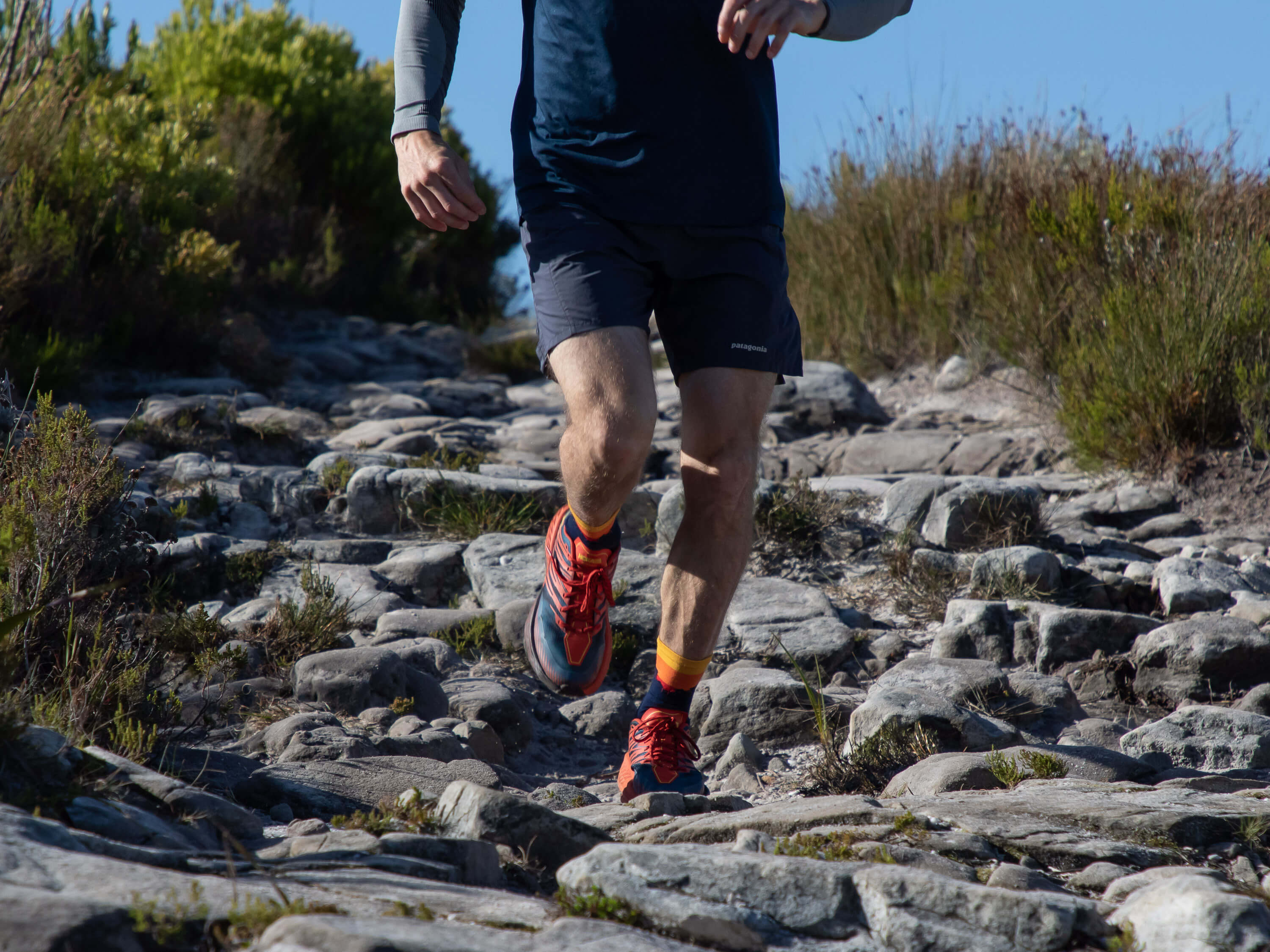
Here, I’ve classified seasoned runners as fast runners or distance runners. In reality many experienced runners will do short faster runs and longer slower runs. If you are this kind of runner, you will probably end up owning two pairs of shoes: one for those faster mid-week runs and another for those longer weekend runs and races.
How to ensure a good fit
One brand’s size 9 can be slightly bigger or smaller than another brand’s size 9, and no two brands will design their shoes around the same last. Everytime you change shoes, you need to reassess size and fit. Do not buy a new pair of shoes until you have tried them on.
Toes need wiggle room
The first thing to check is that you have enough space around your toes. You need to have some space in front of your toes so that they don’t jam up against the front of the toe box on downhill sections – very painful. If you slide your foot to the front of the shoe, you should be able to slide two fingers between your heel and the back of the shoe. Depending on what distances and pace you are going to run in your shoes, you’ll also want some space on either side of your toes so that you have at least a little extra room when your feet swell.
Snug-fitting heel and midfoot
You want to avoid slipping, lifting or rubbing in the midfoot as much as possible, and that means avoiding shoes that are too big behind the toebox – especially if you’re not using them for distance running. But you also don’t want your shoes too tight since that will compromise circulation when your feet start to swell. A good fit should be snug everywhere but tight nowhere. Check that there are no hot spots or pressure points. Your running shoes will not break in, and they need to feel right straight out of the box.
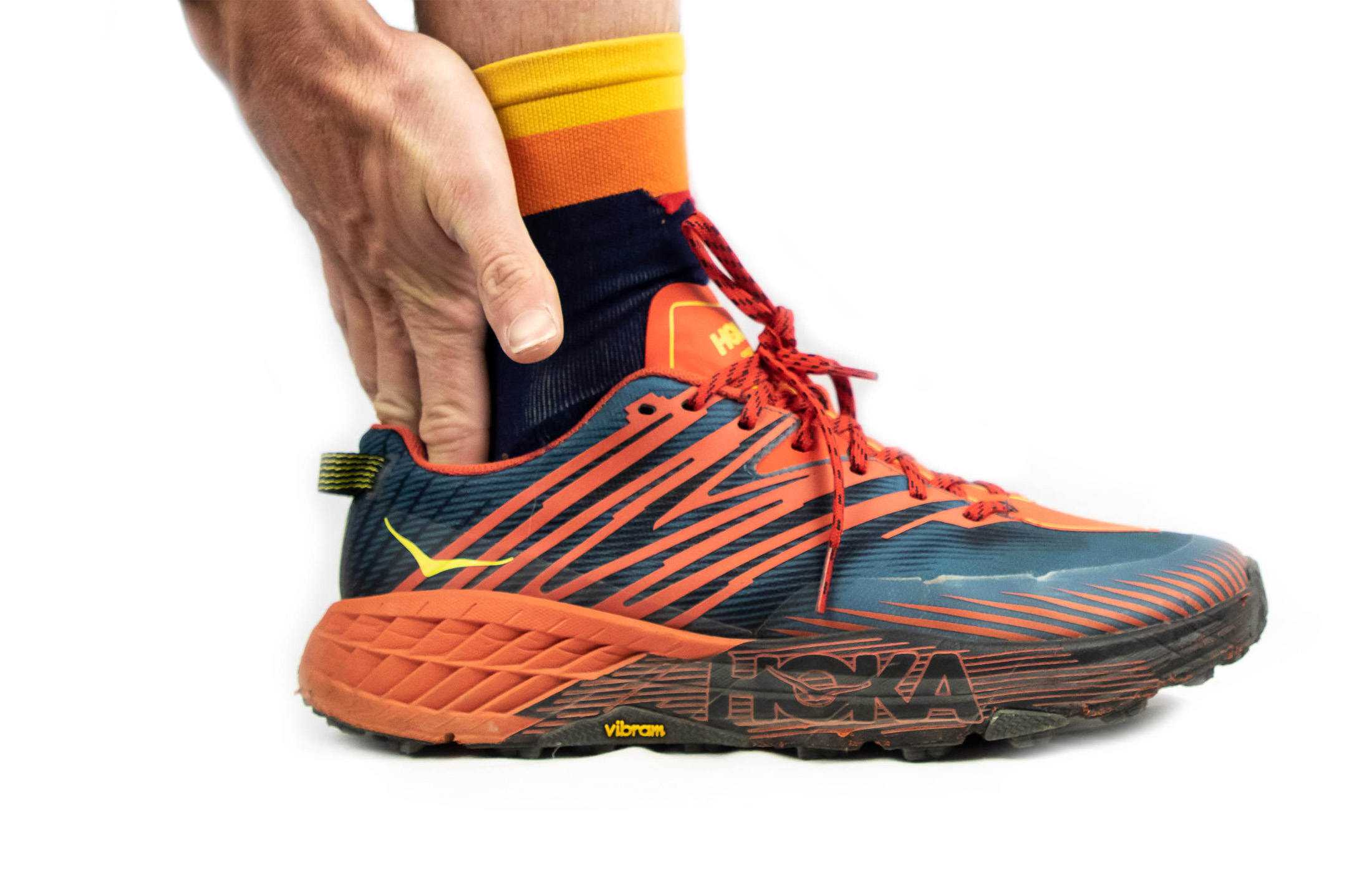
Get more advice from this gearhead
You now know everything you need to know about trail running shoes. But don’t stop here. On this website you’ll find many more in-depth gear guides on everything from tents to trekking poles as well as many more how-to articles. See the links below for favourites or, even better, sign up for my newsletter to get all the latest from Trail & Crag delivered straight to your inbox.
